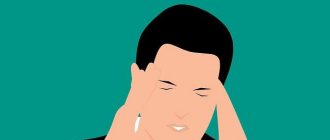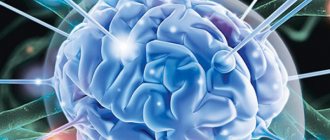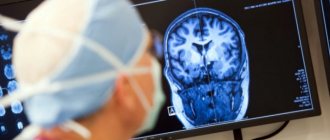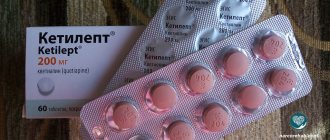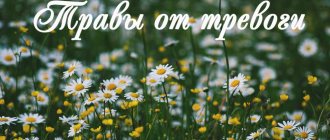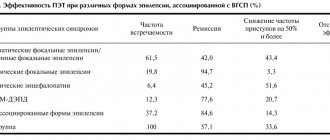Classification of epilepsy
The following main forms of epilepsy are distinguished:
- Isolated (local, partial, focal). It is based on a violation of metabolic processes and blood supply in one part of the brain. In this regard, the following subtypes of isolated forms of epilepsy are distinguished:
- temporal – the patient’s mental activity, hearing, and behavior are disrupted;
- occipital - visual impairment and coordination;
- parietal – causes movement disorders;
- frontal - causes problems with speech.
- Generalized form of epilepsy . It is divided into idiopathic (causes unknown) and symptomatic (occurs as a result of vascular pathologies, tumors and cysts in the brain).
A condition when epileptic seizures follow each other and last more than half an hour is called status epilepticus. This condition poses a real threat to the patient’s life.
Epileptic seizures are divided into several types:
- Partial (focal, local):
- simple - after an attack, a person immediately returns to a normal state, there are no pronounced disorders of brain function;
- complex - after the attack, the patient cannot come to his senses for some time, he loses the sense of time and space, and functional disorders occur in the brain.
- Primary generalized.
- Secondarily generalized.
It should be noted that in severe forms of epilepsy, the patient may have several types of seizures at once.
Causes of epilepsy
The exact causes of epilepsy are unknown . There is a hypothesis that this is a hereditary disease that can be transmitted through generations even from distant relatives.
There are a number of reasons that can trigger the development of the disease. These include:
- stroke;
- brain abscess;
- brain tumors;
- side effect from taking certain medications (neuroleptics, antidepressants);
- malformation (vascular disorders in the brain);
- traumatic brain injuries;
- brain hypoxia at birth;
- chronic alcoholism, drug addiction;
- some parasitic diseases.
Symptoms of epilepsy
Usually, before the onset of an attack, the patient experiences dizziness, sleep disturbances, tinnitus, a feeling of a lump in the throat, numbness of the lips and tongue, and loss of appetite. The person feels general weakness, becomes irritable, and has a headache.
Immediately before a seizure, all patients experience an aura lasting several seconds, after which loss of consciousness occurs, and the following clinical manifestations are observed:
- incoherent cries;
- intermittent breathing, swelling of neck vessels;
- tonic spasms, when the limbs and body are tense, the head is characteristically thrown back, the duration of the spasms is usually about 20 seconds;
- clonic convulsions - appear immediately after tonic ones, manifested by jerky movements of the muscles of the neck, limbs, and body;
- pale skin;
- tight clenching of the jaws;
- noisy breathing, tongue retraction;
- the appearance of foam at the mouth, sometimes with blood (if the patient bit his tongue or cheek during a seizure);
- easing seizures, relaxing the patient’s body.
Causes of seizures
The exact cause of the disease is unknown. But it is precisely established how seizures occur.
Patients experience increased electrical discharges in neurons. Different areas are more excited, which is why different symptoms are observed.
Diagnosis of epilepsy
When making a diagnosis, it is important not only to determine that the patient has epilepsy, but also to find out its type . If epilepsy is secondary, that is, caused by some disease, then this disease is treated first.
Questioning the patient may give the doctor little information, since the person simply does not remember what happened to him during the attack. Therefore, information that can be provided by loved ones who have witnessed epileptic attacks is very important.
In addition to collecting anamnesis, questioning and external examination of the patient, the following methods are used to diagnose epilepsy:
- electroencephalography - determines the altered electrical activity of the brain; it should be remembered that pronounced changes can only be seen during attacks; in a calm state, the EEG may not show anything;
- MRI, CT scan of the brain;
- blood test (general, biochemical).
If secondary epilepsy is suspected, studies are performed to diagnose the underlying disease.
Symptoms and signs of the disease
The most well-known sign is a person falling and convulsing. But you should be aware of other symptoms: lack of reaction to others, sudden freezing, spontaneous and uncontrollable movements. It seems to others that all this makes sense.
With proper treatment, most patients live seizure-free. And a fair question arises: “What folk remedies can cure epilepsy forever?”
Treatment of epilepsy
The treatment regimen for epilepsy is developed by the attending physician, based on the severity of the disease, the frequency of seizures, the age and general condition of the patient, and the presence of concomitant pathologies.
Epilepsy therapy is a long and labor-intensive process . Medicines should be started immediately after diagnosis. Unfortunately, it is impossible to completely cure the disease. Therapy is aimed at preventing attacks and preventing progression of the disease.
The doctor must clearly and clearly explain to the patient and his relatives the importance and meaning of such treatment and convince them that this is a long process.
Only the attending physician can prescribe certain medications, determine their dosage, frequency and duration of administration. If the treatment gives positive results and the patient’s condition improves, then over time the dosage of the drugs may be reduced.
To treat epilepsy, different groups of medications are used : vitamins, anticonvulsants, psychotropic, nootropic drugs. In recent years, doctors have been prescribing tranquilizers.
In addition to drug treatment, the patient needs to change his lifestyle, start eating right, give up bad habits, normalize his work and rest schedule, and not overexert himself. With proper treatment, the patient's condition stabilizes and improves significantly.
As for the treatment of epilepsy in children , the main burden falls on the parents. At the initial stage, the child’s health is monitored by the attending physician, who evaluates the effectiveness of the prescribed medications and ensures that there are no side effects or intoxication of the body.
Then all these indicators should be monitored by parents . Intoxication, vaccination, infectious diseases, a sharp rise in temperature provoke the occurrence of epilepsy attacks.
Before starting treatment for a child for any other diseases, you should consult a doctor to determine whether the prescribed medications will harm the child and whether they are combined with medications taken against epilepsy.
It is very important to ensure the normal psychological state of the child. It is necessary to explain to him how the disease manifests itself, to tell him that he is not to blame for anything and should not be afraid of attacks.
Teachers and caregivers at school or kindergarten should be aware of the child’s illness and have knowledge of how to help him during an attack.
Epilepsy in childhood
Part 6. Read the beginning of the article in No. 6 and 10, 2014 and No. 1, 2015
Treatment of epilepsy is the most important aspect in this group of diseases. In the foreword to his new book, Epilepsy in Children and Adolescents, JW Wheless (2013) points out that “of all the neurological diseases affecting infants, children and adolescents, epilepsy poses a clear challenge to patients, their parents and doctors, requiring significant experience in the assessment and treatment of the disease" [1].
It is quite natural that in order to eliminate epileptic seizures in children, only antiepileptic drugs that are effective against specific types of seizures (or specific forms of epilepsy) should be used. The choice of drugs for the treatment of epilepsy is always determined, first of all, by the effectiveness of a particular drug in various clinical situations [2].
In modern childhood epileptology, such old antiepileptic drugs as, for example, bromides, methsuximide, phenacemide and trimethadione are practically not used. Most of these drugs are insufficiently effective and are also potentially toxic [3].
Traditional antiepileptic drugs such as benzobarbital and primidone are used relatively rarely. Since the 1990s. relatively numerous new antiepileptic drugs have found use in our country; these include lamotrigine, topiramate, oxcarbazepine, levetiracetam, pregabalin, gabapentin, felbamate, tiagabine, perampanel and lacosamide (see below).
Pharmacological drugs for the treatment of epilepsy
Listed below in alphabetical order are first- and second-generation antiepileptic drugs, as well as “conditional” antiepileptic drugs and indications for their use. The so-called “conditional” antiepileptic drugs are those drugs that are initially intended for other therapeutic purposes, but can be used in the treatment of epilepsy and/or status epilepticus (SE) in various clinical situations [3].
In particular, “conditional” antiepileptic drugs are acetazolamide (carbonic anhydrase inhibitor), clomethiazole (anxiolytic/hypnotic), Cortexin (neuropeptide bioregulator with neuroprotective activity), lidocaine (local anesthetic), pentobarbital (short-acting barbiturate from the group of hypnotics) and some others (see below).
The list of pharmacological agents and indications for their use in the treatment of epilepsy is as follows:
- acetazolamide (treatment of epilepsy as part of combination therapy);
- benzobarbital (convulsive, non-convulsive and polymorphic seizures);
- valproate (all types of epileptic seizures);
- vigabatrin (epilepsy with focal seizures - complex and secondary generalized, West syndrome - in combination with other antiepileptic drugs, photosensitivity seizures, complicated febrile seizures);
- gabapentin (epilepsy with focal seizures with or without secondary generalization);
- diazepam (all types of status epilepticus);
- zonisamide (additional treatment of focal seizures in patients over 12 years of age, treatment of epileptic syndromes manifested as myoclonus);
- carbamazepine (focal seizures with or without secondary generalization, primary generalized tonic-clonic seizures, but not other generalized seizures);
- clobazam (focal and tonic-clonic seizures);
- clonazepam (typical absence seizures, initial or additional drug for atypical absence seizures, atonic and myoclonic seizures);
- Cortexin (additional treatment for epilepsy);
- lacosamide (focal seizures with or without secondary generalization in children over 16 years of age);
- lamotrigine (partial, complex focal and primary/secondary generalized seizures, including tonic-clonic seizures, as well as atonic seizures, absences, resistant to therapy with other anticonvulsants; seizures associated with Lennox-Gastaut syndrome in children over 2 years of age);
- levetiracetam (adjunctive therapy in the treatment of epilepsy with partial seizures with or without secondary generalization in children from 4 years of age);
- lorazepam (status epilepticus, serial epileptic seizures in children - in combination with basic antiepileptic drugs, neonatal seizures resistant to treatment with phenobarbital and/or phenytoin; treatment of complex focal seizures, symptomatic convulsive states);
- nitrazepam (West syndrome, some other forms of seizures);
- oxcarbazepine (as monotherapy or in combination with other antiepileptic drugs for focal seizures with or without secondary generalization, for primary generalized tonic-clonic seizures);
- perampanel (as an adjuvant for the treatment of focal seizures in patients with epilepsy over the age of 12 years with or without secondary generalized seizures);
- pyridoxine (vitamin B6-dependent epilepsy, complex treatment of other pharmacoresistant forms of epilepsy in children);
- pregabalin (additional treatment of focal seizures with or without secondary generalization - from 17 years of age);
- primidone (epilepsy of various origins - mainly grand mal seizures; less effective for focal, myoclonic, akinetic seizures);
- stiripentol (complex treatment of refractory attacks of generalized tonic-clonic seizures in children with Dravet syndrome - in combination with clobazam and valproate, used in the absence of effect from clobazam and valproate);
- sulthiam (focal seizures and rolandic epilepsy, West syndrome);
- tiagabine (therapy of focal and generalized epileptic seizures);
- topiramate (focal or generalized tonic-clonic seizures - as monotherapy or in combination with other antiepileptic drugs, additional therapy for seizures associated with Lennox-Gastaut syndrome, newly diagnosed epilepsy in children from 2 years of age);
- felbamate (an adjuvant for the treatment of focal and generalized epileptic seizures in Lennox-Gastaut syndrome that cannot be treated with other drugs - from 4 years of age);
- phenyloxopyrrolidinylacetamide (status epilepticus, epilepsy and convulsive conditions);
- phenytoin (generalized tonic-clonic, simple and complex focal, and psychomotor seizures; status epilepticus);
- phenobarbital (all types of epileptic seizures, except absence seizures; status epilepticus);
- folic acid (treatment of folate-responsive forms of epilepsy, as well as additional treatment of cognitive impairment and intellectual disorders in epilepsy - in combination with or without vitamin B12);
- fosphenytoin (generalized tonic-clonic, simple and complex focal, as well as psychomotor seizures, status epilepticus);
- ethosuximide (various variants of minor seizures of primary and secondary generalization, in some cases - during myoclonic seizures) [3–12, 22].
Restrictions on the use of various drugs listed (in addition to age-related ones) for epilepsy mainly relate to the ability of these drugs to induce seizures and/or aggravate the manifestations of this group of diseases. It is appropriate to recall here that only valproic acid preparations are considered effective in the treatment of all known types of epileptic seizures, without, in addition, having the ability to aggravate them (with the exception of epileptic syndromes accompanying mitochondrial pathology and some other metabolic disorders in children) [3 ].
The potential possibility of correction with the help of antiepileptic drugs of non-epileptic disorders associated with epileptiform activity, considered in the work of V. Yu. Nogovitsyn et al. (2006) and supported by some neurologists, is extremely controversial and controversial [13]. Antiepileptic drugs vigabatrin, tiagabine, clobazam, and sulthiam were not registered in the Russian Federation as of mid-2015.
Medicines for the symptomatic treatment of epilepsy
In the symptomatic treatment of vascular and cognitive disorders in epilepsy in children, the vascular drugs vinpocetine and cinnarizine, nootropic agents are used: aspartic acid (Cogitum), hopantenic acid (Calcium hopanthenate), Glycine, Piracetam, Semax (0.1% solution), Cortexin, phenyloxopyrrolidinylacetamide and others [3, 5, 6, 8, 14].
If vinpocetine, cinnarizine and Piracetam are relatively widely used in various countries (besides the Russian Federation and the CIS), then Semax, Cortexin, hopantenic acid and phenyloxopyrrolidinylacetamide are used in the treatment of epilepsy almost exclusively in our country.
Drugs for the treatment of epileptic stutus
Among the drugs for the treatment of status epilepticus, there are both antiepileptic drugs and representatives of other drug groups: sodium valproate (parenteral forms), diazepam, chloral hydrate (rectal), paraldehyde, magnesium sulfate, sodium thiopental, lorazepam, pentobarbital (for administration to barbiturate coma) , midazolam, lidocaine, propofol, clomethiazole (ethane disulfonate of chlormethiazole), phenyloxopyrrolidinylacetamide, phenytoin, fosphenytoin [3–6, 8, 12].
The latest edition of the “Federal Guidelines for the Use of Medicines (Formulary System)” (2012) does not present all of the listed drugs that are used in the treatment of status epilepticus in various countries of the world [8]. In particular, this pharmacological reference does not contain any mention of drugs such as pentobarbital and fosphenytoin.
Metabolic agents in the treatment of epilepsy
There are a number of neurometabolic agents used in pediatric epileptology. In particular, these include creatine, Reamberin and coenzyme Q10 (dietary supplement) (complex therapy of various types of primary and secondary mitochondrial pathology with damage to the central nervous system and manifestations in the form of epileptic seizures), levocarnitine/L-carnitine (carnitine deficiency in patients with epilepsy taking valproate; methylmalonic and propionic acidemia), ornithine (epileptic seizures due to urea cycle disorders and other conditions accompanied by hyperammonemia), serine (epileptic seizures significantly associated with defects in the biosynthesis of this amino acid), tetrahydrobiopterin/sapropterin (epileptic seizures associated with phenylketonuria and tetrahydrobiopterin deficiency), flupirtine and cysteamine (neuronal ceroid lipofuscinosis), etc. [3].
There are other metabolic agents used to treat epileptic seizures in specific clinical situations.
Experimental drugs to treat epilepsy
New (experimental) drugs potentially intended for the treatment of epilepsy and status epilepticus include the following: brivaracetam, valrocemide, isovaleramide, carabersate, carisbamate, losigamon, remacemide, retigabine, rufinamide, safinamide, seletracetam, soretolide, stiripentol, talampanel, fluorofelbamate, eslicarbaze pin , DP-valproic acid. Some of them have been undergoing clinical trials in various phases over the past years. Brivaracetam is believed to be 10 times more effective than oxcarbazepine for certain types of seizures under experimental conditions.
It is expected that in the near future the arsenal of antiepileptic drugs will be significantly expanded with third-generation drugs [13, 15].
Alternative and complementary therapies for epilepsy
There are methods of alternative and complementary therapy for epilepsy, which are divided into medicinal and non-medicinal.
Among the methods of alternative pharmacological treatment of epilepsy used in various clinical situations, one should list hormonal agents (synthetic analogue of adrenocorticotropic hormone - tetracosactide, corticosteroid hormones - prednisolone, dexamethasone, natural and synthetic progesterone and its metabolites), neuropeptide bioregulator Cortexin, human immunoglobulins for intravenous administration , antiviral agents (acyclovir, ganciclovir) [3, 14, 16, 17]. The latter are intended for selected cases of Rasmussen's encephalitis [18].
The main methods of alternative non-drug treatment of epilepsy include neurodietological approaches: ketogenic diets (classical - according to RM Wilder, liberalized - based on medium-chain triglycerides according to PR Huttenlocher, as well as other options - John Radcliffe, Great Ormond Street, diet based on long-chain triglycerides, diet on based on corn oil, etc.), modified Atkins diet, oligoantigenic diets, diet with a low glycemic index, exclusion of antinutrients (aspartame, monosodium glutamate, etc.), use of vitamins (vitamin therapy), supplementation of polyunsaturated fatty acids (PUFAs) and/ or mineral substances, the use of dietary supplements and substances (lecithin, carnitine, taurine, dimethylglycine, quercetin, coenzyme Q10, etc.), agliadine (gluten-free) diet (for epilepsy associated with celiac disease - Gobbi syndrome), the use of edible medicinal plants and drugs based on them [3, 7, 12, 19].
At least 4 types of neurosurgical intervention for epilepsy are known: 1) focal resection/lobectomy (removal of one lobe, usually the temporal lobe); 2) subpial transsection/topectomy (removal of the cortex); 3) hemispherectomy (removal of one hemisphere of the brain); 4) corpuscallosotomy (separation of the hemispheres of the cerebral cortex by dissecting the corpus callosum) [3, 13, 12, 15].
Focal resection is used for epileptic seizures with a focal onset that developed in the removed area of the cerebral cortex. Subpial transection is indicated for tonic, clonic or tonic-clonic seizures with falls and physical damage; with large lesions that cannot be resected, and also in the presence of secondary bilateral synchronization. Hemispherectomy is used for Rasmussen syndrome or other types of unilateral pathology of the cerebral hemispheres associated with functional disorders in the contralateral upper limb. Corpuscallosotomy is indicated for epileptic seizures with onset in the form of focal seizures emanating from an area of the cerebral cortex that is not subject to resection [3, 12, 13, 15].
The pharmacoresistance of epilepsy must always be proven before a decision is made on the possibility of surgical treatment. Absolute contraindications to surgical treatment are degenerative and metabolic disorders [3].
Vagal stimulation (electrical stimulation of the vagus nerve using an implanted device) occupies a special place among the methods of neurosurgical treatment of epilepsy. This method of therapy is considered indicated in the presence of localization-related seizures (with or without secondary generalization), as well as in generalized seizures refractory to traditional antiepileptic therapy [3, 13].
Other alternative non-drug treatments include biofeedback (BFB), acupuncture (traditional acupuncture and electroacupuncture), psychotherapy, hypnosis, and therapeutic plasmapheresis. The latter can be performed in patients with drug-resistant forms of epilepsy or in cases of toxic effects of antiepileptic drugs as a method of removing pathogenic elements from the blood (toxins, antibodies, circulating immune complexes, paraproteins, etc.).
Homeopathy, herbal medicine and aromatherapy, polarized light, and the use of specially trained dogs (seizure alert dogs) are used. Electroconvulsive therapy has been replaced by the method of magnetic convulsive therapy [3].
The relationship of evidence-based medicine to alternative therapy for epilepsy
The vast majority of methods of alternative and complementary therapy for epilepsy (especially non-pharmacological ones) are difficult to evaluate from the standpoint of evidence-based medicine.
However, the effectiveness of the vagal stimulation method is considered confirmed in the treatment of focal epileptic seizures. Only relatively recently (in 2012) evidence-based medicine recognized the effectiveness of ketogenic diets, confirming “short- and medium-term positive effects in the control of epileptic seizures, comparable to those of modern antiepileptic drugs.”
Psychological therapy, including combined relaxation, behavioral therapy and biofeedback, does not have verified evidence of effectiveness. In a systematic review on the use of acupuncture in epilepsy, DK Cheuk and V. Wong (2008) conclude that there is insufficient evidence to state the effectiveness of this method [20]. Despite the possibility of using therapeutic plasmapheresis for epilepsy, there are no objective data to establish the superiority of this therapeutic regimen over others. Hypnosis is a controversial method of treating epilepsy, the positive effect of which on the condition of patients with epilepsy has not been confirmed. Aromatherapy, in particular inhaling the aromas of camphor and rosemary, can lead to a worsening of the condition of patients with epilepsy and an increase in the frequency of seizures. The effectiveness of polarized light in epilepsy does not stand up to criticism at all [3].
Pediatric neurologists should be critical of alternative therapies for epilepsy, but not completely neglect them, since in this case the possibilities of overcoming drug resistance of the disease will be ignored.
Prognosis for epilepsy
Since the term “epilepsy” itself is collective, and its content includes dozens of different epileptic syndromes, it is quite natural that the prognosis for certain forms of the disease can vary significantly.
Approximately 5% of people experience at least one seizure throughout their life, which is not subsequently accompanied by the development of epilepsy. The risk of a second epileptic seizure 3 years after the first is 27–84%. The risk of a third seizure in a patient who has previously had 2 unprovoked seizures is quite high (about 73%).
The most important factors that determine the immediate and long-term prognosis of epilepsy are the following: etiology, quality of life, timely initiation of therapy, achievement of remission, withdrawal of antiepileptic therapy, mortality, cognitive-behavioral aspects, social-cognitive aspects of epilepsy. First of all, the prognosis of epilepsy in children is determined by the response to therapy with antiepileptic drugs in the first 6–12 months; a certain importance is given to the presence/absence of concomitant neurological diseases [3, 13, 15, 21].
The prognosis for symptomatic epilepsy is always considered as more serious (less favorable) than for cryptogenic and idiopathic forms of the disease. The risk of recurrence of epileptic seizures after stopping antiepileptic drugs after at least a complete 2-year remission is about 20% for children (about 40% for adults) [3, 21].
The long-term prognosis of epilepsy is determined not only by the relief of seizures, but also by the preservation or deficiency of cognitive functions. Social outcome in epilepsy depends primarily on cognitive function, antiepileptic drug therapy, and psychosocial factors. Early diagnosis of the disease (before the development of a long period of cognitive impairment), adequate antiepileptic treatment aimed at eliminating seizures and changes in electroencephalography, as well as active neuropsychological rehabilitation are the best guarantee of avoiding pronounced neuropsychological consequences of epilepsy [13, 15].
The general prognosis for seizure control in epilepsy is relatively favorable; from 70% to 80% of patients (with therapy) become free from seizures, and in half of them antiepileptic treatment can be discontinued. Approximately 5% of children with drug-resistant forms of epilepsy are unable to lead a normal life and are dependent on others for daily activities [3].
Conclusion
In general, it should be recognized that over the past decades, representatives of neuroscience and clinical medicine have achieved a certain breakthrough in understanding the etiopathogenetic mechanisms of epilepsy in patients of different ages, which was greatly facilitated by advances in the field of neurochemistry, neurogenetics, neuroimmunology and neuropsychology. As a result, approaches to the diagnosis and treatment of epilepsy in children and adults have been optimized, although this group of chronic paroxysmal disorders of cerebral functions continues to remain one of the most pressing problems in neurology.
Literature
- Wheless JW (ed). Epilepsy in children and adolescents. Oxford (UK)-Hoboken (NJ, USA). Wiley-Blackwell. 2013, 378 p.
- Ermakov A. Yu., Balkanskaya S. V. Choice of antiepileptic drug: effectiveness and cognitive control // Medical advice. 2007. No. 3. pp. 12–15.
- Epilepsy in neuropediatrics (collective monograph) / Ed. Studenikina V. M. M.: Dynasty, 2011. 440 p.
- Patient management protocol. Epilepsy // Problems of standardization in healthcare. 2005. No. 3. P. 4–73.
- Register of Medicines of Russia "Encyclopedia of Medicines". 21st edition, revised. and additional M.: RLS-2013.
- Vidal Directory. Medicines in Russia: Directory. Publishing house 19th, M.: AstraPharmServis, 2013.
- Studenikin V.M., Shelkovsky V.I., Balkanskaya S.V. Epilepsy in children of the first three years of life (parts 1–2) // Pediatrician’s Handbook. 2009. No. 3–4. pp. 3–17, 4–22.
- Federal guidelines for the use of medicines (formulary system). Vol. XIII. M., 2012.
- Antiepileptic drugs (Levy RH, Mattson RH, Meldrum BS, Perucca E., eds.). 5 th ed. Philadelphia/Baltimore. Lippincott Williams&Wilkins/A Wolters Kluwer Co. 2002. 968 p.
- Kneen R., Appleton RE Alternative approaches to conventional antiepileptic drugs in the management of paediatric epilepsy // Arch. Dis. Child. 2006. Vol. 91. P. 936–941.
- Oxford American Neurology Library (OANL) Antiepileptic drugs: a clinician's manual (Asadi-Pooya AA, Sperling MS, eds.). Oxford-New York. Oxford UniversityPress. 2009. 250 p.
- Shorvon S., Perucca E., Engel J. Jr. (eds). The treatment of epilepsy. 3rd ed. Chichester (UK). Wiley-Blackwell/A John Wiley & Sons, Ltd. 2009. 1076 p.
- Encyclopedia of basic epilepsy research/Three-volume set (Schwartzkroin P., ed.). vol. 1–3. Philadelphia. Elsevier/Academic Press. 2009. 2496 p.
- Guzeva V.I., Trubacheva A.N. Use of cortexin in the complex treatment of epilepsy in children // Terra Medica. 2003. No. 2. P. 19–21.
- Epilepsy: A comprehensive textbook (Engel J., Pedley T.A., eds.). 2nd ed. vol. 1–3. Lippincott Williams&Wilkins/A Wolters Kluwer Business. 2008. 2986 p.
- Nolan MA, Carter Snead O. III. Adrenocorticotropin and steroids. Chapter 67. In: The treatment of epilepsy: Principles and practice (Wyllie E., ed.). 4 th ed. Philadelphia/Baltimore. Lippincott Williams & Wilkins. A Wolter Kluwer Co. 2006. P. 931–938.
- Vincent A., Irani SR, Lang B. The growing recognition of immunotherapy-responsive seizure disorders with autoantibodies to specific neuronal proteins // Curr. Opin. Neurol. 2010. Vol. 23. P. 144–150.
- Shelkovsky V.I., Studenikin V.M., Maslova O.I. Rasmussen syndrome in children: features of clinical manifestations and treatment // Issues. modern pediatrics. 2004. T. 3. No. 3. P. 66–69.
- Ranganathan LN, Ramaratnam S. Vitamins for epilepsy // Cochrane Database Syst. Rev. 2005. (2): CD004304.
- Cheuk DK, Wong V. Acupuncture for epilepsy // Cochrane Database Syst. Rev. 2008, (4): CD005062.
- Smith RL Withdrawing antiepileptic drugs from seizure-free children // Aust. Prescr. 2006. Vol. 29. P. 18–21.
- Nogovitsyn V. Yu., Nesterovsky Yu. E., Osipova G. N., Rusakova V. D. et al. Epileptiform activity in children without epilepsy: clinical and electroencephalographic correlations // Zh. neurol. psychiatry. 2006. T. 106. No. 6. P. 42–46.
V. M. Studenikin, Doctor of Medical Sciences, Professor, Academician of the Russian Academy of Economics
FSBI "NTsZD" RAMS, Moscow
Contact Information
* The drug is not registered in the Russian Federation.
Treatment of epilepsy with traditional methods
Traditional methods are not always able to permanently cure a person from epilepsy or other diseases whose nature is neurological in nature. And folk methods, developed over centuries, allow a person to get rid of not only periodically recurring crises. They eliminate the origins of the disease.
An irresponsible attitude towards one’s health or a delay in the treatment process leads to the fact that a person suffering from an attack of “falling sickness” additionally develops dementia, personality changes occur, hallucinations occur, and groundless mood disorders are noted. After all, epilepsy is a problem with the neurons of the brain.
Treatment of epilepsy with stone oil
As modern research has shown, the medicinal drug known since ancient times called “stone oil” contains approximately seven dozen substances beneficial to the body. It is not for nothing that this healing balm was called the food of immortals for thousands of years in the East, and in the Middle Ages it was known as the elixir of immortality.
This substance is of mineral, that is, natural origin. And although it is mined in the mountains, with mumiyo - a similar high-mountain element, but of organic origin, rock oil (another name for it is white mumiyo) has nothing in common.
The substance has the ability to normalize metabolism. It has the following properties:
- immunomodulatory;
- antispasmodic.
You can use a solution prepared on the basis of stone oil according to the “Siberian” recipe. This drug really helps with epilepsy.
The method of preparing the medicine is simple : 3 g of stone oil is separated and filled with two liters of water. This solution is drunk before meals three times a day. Single serving – 1 glass. Duration of treatment – 1 month. It is advisable to repeat the course of taking stone oil only once annually, not more often.
Therapeutic baths for epilepsy
An obligatory part of treatment with folk remedies. This method gives a relaxing effect. But their number cannot exceed 15.
Add 300 grams of pine needles to 2 liters of water. Boil the decoction. Then filter and dilute with water at a temperature of 38. Suitable for children and adults, you can do it once every 4 days.
For 1 liter of water you need to add 200 grams of lemon balm. Daily for 15 minutes.
Peppermint tincture: step-by-step description of production and instructions for using the tincture (95 photos and videos)Anti-seizure drugs - causes of seizures, anti-convulsant drugs, classification of drugs and treatment with tablets (95 photos)
- Remedies for seizures - causes, treatment and features of taking medications (115 photos)
You need a handful of valerian officinalis roots, which is added to 1 liter of water and boiled for 10 minutes. Strain and dilute with water. Use this remedy once every 2 days.
As we can see, some folk remedies for epilepsy are also suitable for children.
Maryin root: a real counteraction to epilepsy
This perennial herb, also called peony evasive, has long been used in folk medicine:
- with neurasthenia;
- with paralysis;
- for epilepsy;
- for other neurological diseases.
Alcohol tincture is used as a medicine . Flower petals in a volume of 3 tbsp. l. pour half a liter of vodka.
The product is infused in a dark place for 20 days to 1 month. After which it is drunk 2-3 times during the day. A single dose of medicine is 1 teaspoon.
Mono-infusions for epilepsy
You will need Art. spoon of medicinal letter It needs to be steamed in a glass of boiling water, kept in a thermos for 2 hours, strained. Drink 1 large spoon 3 times a day. Helps against epilepsy with hypertension and liver disease.
For one and a half cups of hot water, 40 grams of wormwood are kept for 4 hours, wrapped in cloth. Drink 0.5 cups 2 times a day before meals.
For 220 ml. boiling water you will need tbsp. spoon of rue. After an hour, strain. Drink a large spoon 3 times. in a day.
Treatment of atherosclerosis: ways and methods of how to cure blood vessels. The best remedies and drugs for the treatment of atherosclerosis (120 photos)Celandine tincture - treatment with celandine, recipes and application (video + 105 photos)
Treatment of chronic runny nose - step-by-step description and treatment in adults and children (105 photos)
Herbal powder for the treatment of epilepsy
The following ingredients of plant origin are used in equal parts:
- licorice;
- duckweed;
- peony.
They need to be crushed and mixed using a coffee grinder or a regular mortar until it becomes a powder. Half a teaspoon is separated for one-time use. After completing a two-week course, a week break is taken in treatment. Then the course is repeated.
Consumption of the powder by the end of the first course will certainly show a positive result. However, it is advisable to take 3 such courses so that the improvement becomes stable.
Surgery
Before proceeding to radical methods of treating epilepsy, the patient must undergo a course of medication and, possibly, chemotherapy. Only after the results obtained do not indicate positive dynamics can you turn to surgery. The main indication for surgical treatment is the resistance of seizures to drugs and drug therapy. Neurosurgery is the best option for patients with drug-resistant epilepsy. The surgical operation is to eliminate the source of epilepsy. It is an effective and safe treatment method. After the operation, there is an absence of seizures, which is a factor in improving the quality of life and psychosocial adaptation of patients. Surgical operations are performed in exceptional, especially severe cases in order to remove the formation that causes mechanical irritation of the brain, as well as to perform cortexectomy and partial callosotomy.
The aroma of myrrh for chronic epilepsy
Both during a crisis and when the patient’s condition is stable, the smell of myrrh should be present in the room, and constantly. This resin with aromatic properties is used by church workers.
A little myrrh is placed in a metal bowl and set on fire. Let this aroma from smoking resin spread throughout the rooms before going to bed. This scent also helps:
- for neuroses;
- for insomnia;
- for chronic fatigue.
This technique has been known since ancient times. People with epilepsy noticed that the general church atmosphere had a beneficial effect on them. Even without understanding the nature of epilepsy, the clergy used myrrh during exorcism, when the epileptic was convulsing.
Photos of folk remedies for epilepsy
- Treatment of thrombophlebitis - classification and symptoms of thrombophlebitis. Treatment options with drugs and traditional methods (110 photos)
- How to treat lichen - a review of the most effective drugs at home (115 photos and videos)
- Wormwood medicinal properties - treatment and cleansing of the body with the help of wormwood. Tips for collecting, storing and preparing medicines (95 photos)
Read here! Medicinal properties of oak bark: indications and contraindications for the use of oak bark decoction (70 photos)
Please repost
0
Recommendations for patients with epilepsy regarding diet and lifestyle
- Epileptics are advised to include more in their diet:
- spinach;
- Luke;
- freshly squeezed juices.
- Physical activity of any kind will help avoid crisis conditions. It is advisable for sick people to systematically engage in:
- jogging;
- charging;
- active physical labor.
- Epilepsy is a disease usually with a chronic form , so you should monitor your condition and be treated with simple traditional methods systematically and continuously.
However, excessive zeal can bring the opposite result: overexertion can lead to the transition of a “dormant” disease into an active form.
It is advisable to purchase medicines only from proven suppliers, otherwise you can get ordinary dummies or falsified counterfeits instead of valuable drugs.
Where can I buy
The main components for preparing ointments or tinctures in Moscow can be purchased any day if you go to one of the Russian Roots herbal pharmacies. Experienced pharmacists will provide advice on choosing a more effective form of treatment, taking into account the individual condition of the patient.
All popular drugs can be prescribed through the website of the same name. The medicine will be delivered quickly if the customer lives in Moscow or in the near Moscow region. If you need to deliver the medicine to a more remote area, then the parcel will be sent by mail.
Prevention of epilepsy
The main measures to prevent epilepsy are:
- compliance with safety rules, prevention of traumatic brain injuries;
- rejection of bad habits;
- proper nutrition, avoidance of junk food and caffeine-containing products (coffee, energy drinks, strong tea);
- normalization of work and rest regimes;
- avoiding stress;
- regular walks in the fresh air, physical education;
- preventing overheating or hypothermia of the body;
- timely treatment of somatic and nervous diseases.
